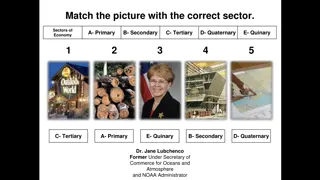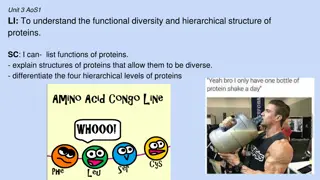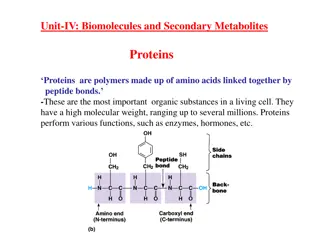Economic Activities and Sectors Overview in Human Geography
The primary, secondary, and tertiary sectors play crucial roles in how people make a living, with examples ranging from extracting raw materials to providing services. The primary sector focuses on natural resource extraction, the secondary sector on manufacturing, and the tertiary sector on service
2 views • 30 slides
Understanding Economic Activities and Their Classification
Economic activities encompass the production, distribution, and consumption of goods and services within a society. Economists classify economic activities into four main sectors: Primary, Secondary, Tertiary, and Quaternary, each with distinct roles and functions. The Primary Sector involves raw ma
5 views • 12 slides
Understanding Economic Sectors: Primary, Secondary, Tertiary, Quaternary, and Quinary
Explore the different sectors of the economy - primary, secondary, tertiary, quaternary, and quinary - and learn about the types of activities and occupations associated with each. Discover how the quaternary sector differs from the quinary sector and gain insights into the intellectual activities a
0 views • 5 slides
Overview of Organic Compounds Nomenclature
Nomenclature of organic compounds involves assigning names based on two main systems - Trivial system and IUPAC system. Trivial system utilizes names related to discoverers or sources, often with Latin or Greek roots. Saturated hydrocarbons, known as paraffins, contain single bonds and are less reac
0 views • 27 slides
Understanding Economic Development: Measures and Indicators
Economists measure economic development using indicators like the Human Development Index, life expectancy, birth rate, mortality rate, and GDP per capita. Different levels of development are associated with specific economic activities, from primary industries like agriculture to quaternary activit
0 views • 11 slides
Understanding Protein Tertiary Structure and Motifs
Protein tertiary structure, essential for enzyme function and protein design, refers to the overall three-dimensional arrangement of amino acid side chains in a protein chain. This structure is specific to each protein sequence, with domains and motifs playing key roles in protein architecture. Prot
0 views • 13 slides
Understanding Quaternaries in Semiconductor Nanodevice Design
Learn about the treatment of quaternary materials in semiconductor nanodevice simulations, including material parameters needed for GaAs/AlGaAs heterostructures and interpolation techniques for ternaries. Explore the complexities of AlxGa1-xAsyP1-y and AlxGa1-xIn1-x-yAs quaternaries, along with the
0 views • 10 slides
Understanding Protein Structure and Function Diversity
Proteins, composed of amino acids connected by peptide bonds, are crucial in all living organisms. They exhibit a wide range of functions and structural diversity. The hierarchical levels of proteins include primary, secondary, tertiary, and quaternary structures, each vital for proper protein funct
0 views • 12 slides
Understanding the Hierarchy of Protein Structure
To understand proteins' final shape and function, one must grasp the primary, secondary, tertiary, and quaternary structure levels. Proteins, composed of amino acids, fold into various shapes crucial for their roles such as signaling, catalysis, and structure. The primary structure represents the am
0 views • 28 slides
Understanding Proteins: Structure and Function
Proteins are vital organic compounds composed of amino acids linked by peptide bonds. They serve various functions in cells, such as enzymes and hormones. Amino acids are the building blocks of proteins, with 20 different types forming all proteins on Earth. Proteins have four levels of structure -
0 views • 12 slides
Understanding Climate Change: Causes, Effects, and Responses
Explore the causes, effects, and responses to climate change in this comprehensive study. From the changes in climate over the Quaternary period to the role of greenhouse gases, farming, and weather patterns, delve into key questions and keywords related to this urgent global issue.
0 views • 9 slides
Understanding Different Forms of DNA Structures
DNA can exist in various forms such as single-stranded, double-stranded, and mixed forms. The primary, secondary, and tertiary/quaternary structures play crucial roles in determining the overall structure of DNA. Forms like A-DNA and B-DNA have distinct characteristics and are commonly found in diff
0 views • 57 slides










